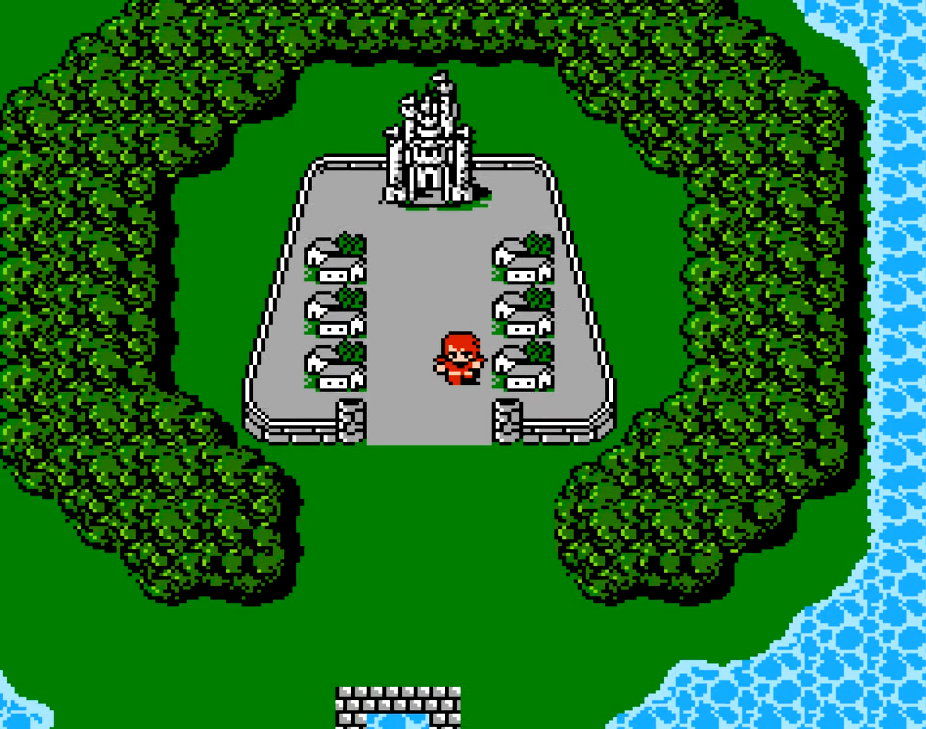
Version played: NES (w/ bugfix patch)
Being the game that kicked off the whole series, Final Fantasy 1 is a bit of a weird game to experience if you’re used to more modern JRPGs. There’s a strange dichotomy between ideas and systems that went on to become staples of the series (and by extension the genre as a whole), and those that either fell by the wayside completely or are seldom seen in the mainstream nowadays. It's a very derivative game, with a lot of the standard JRPG DNA coming from the foundation laid by Dragon Quest, but there's something to be said of the inspiration it draws from both tabletop games like Dungeons & Dragons as well as the games that spawned from D&D like Ultima and Wizardry. The whole game is clearly very heavily inspired by those titles, a notable point being that the game’s enemy roster is essentially a flip of D&D’s Monster Manual.
Right after starting the game, you’re greeted by the option to choose your party’s classes, as one would in the aforementioned Wizardry or Ultima. The classes are standard RPG and Final Fantasy fare, and while you can make it through the game with pretty much anything as long as you have at least one White Mage, one party composition reigns supreme: Warrior, Monk, White Mage, and Black Mage. Warrior is your standard weaponmaster physical fighter, with high single-target damage that makes it invaluable for most boss fights, and the character that most of your gear upgrades will be going to. Monk, meanwhile, chooses to forgo weapons entirely, their damage scaling much higher when unarmed when compared to their weapon damage. They fill the role as the second physical damage dealer that you don't really need to worry about gearing. White Mage is a no-brainer, as they're the only real healer you're going to get and you're basically dead in the water without one. Black Mage, though falling off somewhat as the game goes on due to the limit of 9 maximum charges for each given tier of spell, is so invaluable for mobbing in the early game that as much as I would love to have taken a Red Mage, it was better in the long run to just stick to a Black Mage. A shame, since Red Mage has my favourite design out of the original FFI jobs, but in my opinion it's better to have a unit that does one thing really well than a unit that can do two things pretty alright.
It’s a very simple game, with most of the story and objectives amounting to little more than “go here” and then “grab this item” or “kill this boss.” Granted, that’s a statement you could make about any game if you boiled them down to their essentials, but there’s typically something larger pulling you along for the ride. Not so here. You and your party are the four heroes of light, blessed heroes who possess four (at the moment) dormant elemental crystals. After appearing suddenly near the city of Cornelia and rescuing the princess from the clutches of Garland, the king of Cornelia builds a bridge so you can continue... adventuring. As far as I can remember, you don't even get a specific goal like "defeat Chaos" or "free the crystals." I'm not even sure you're told that the crystals relight upon defeating one of the Four Fiends, you're just expected to notice that they do. The narrative is actually extremely light until close to the end where you enter a village and like twelve old guys are just standing in a circle and each of them recounts a different part of the game’s plot and final narrative twist to you. This was extremely funny, by the way, and I'm really hoping Stranger of Paradise has something akin to this when I get to it approximately 300 years from now. The story has some interesting concepts, like the time loop and everything with Garland/Chaos, but that’s just it: they're concepts; ones that aren't really used past their initial inception. The ideas it has are solid, but at the end of the day, that's all they are. A bunch of decent ideas expanded on by future games until they became series and genre staples.
The whole game is like that. It isn't necessarily a bad game, on the contrary, it's pretty good! It doesn't really do anything wrong, but at the same time it doesn't really do anything particularly interesting either. Most of what it offers is simply combining things done better both by its contemporaries and its predecessors. It's not as pure of an adventure as Dragon Quest, and it isn't as good of a party-based dungeon crawler as Wizardry or The Bard's Tale. It's something more unique, at least in the console space at the time. Something that would go on to define the modern structure of JRPGs as a whole: it's an experience. A dedicated ride, designed to show you the all the cool stuff in the game that the developers worked really hard on, but with just enough freedom that you feel like you're still making your own way through it. Most games play this dance of smoke-and-mirrors to some degree, but FF1 really puts effort into making it the central point of it's design.
It's not really in a bad way, though. I still think everyone should play this if you're interested in JRPG or FF history. It's not the most influential game in the series, as those would come later, but it's still a fun time, and worth playing.
Just as a small note, I played with a bugfix/retranslation patch and a double experience and money patch to reduce my time spent grinding for levels and spells. This ultimately didn’t change much but it did make looking for information on equipment more difficult than it should have been since the names were different.
